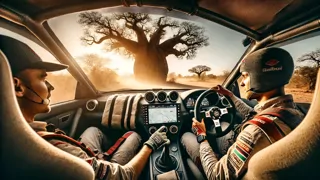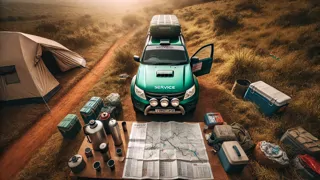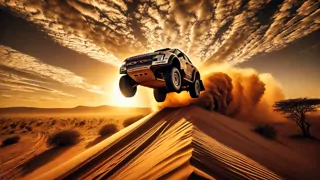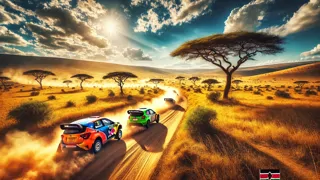Introduction
The roar of engines reverberates across the early morning air as dawn breaks over Kenya’s rolling plains and rugged hills. A dozen rally machines, each meticulously tuned and bursting with raw power, line up at the start gate, their drivers and co-drivers adjusting helmets, checking wrist straps, and exchanging determined glances. Golden light slips between acacia silhouettes while whip-thin dust clouds rise behind every vehicle, hinting at the grueling marathon ahead. In this race, called Race Forever, you hold the fate of both car and crew in your hands. Your first choice is crucial: selecting a co-driver whose instincts match your style, whose expertise can guide you through hidden traps, and whose calm voice will keep you focused when the track dissolves into a thunderous blur. Next comes the planning: dozens of route options wind through highland coffee plantations, along sun-baked riverbeds, into dense montane forests where rain leaves mud that can swallow tires whole. You’ll conquer sweeping dunes by the Indian Ocean, battle crosswinds on exposed ridges, and thread through narrow valleys where a single mistake could spell disaster. Each leg demands careful navigation, mechanical savvy, and sheer grit. This introduction marks the moment you decide what kind of racer you are: a strategist balancing risk and reward, an adventurer hungry for every challenge, or a competitor driven by the promise of glory on Africa’s untamed soil. Your journey begins now—choose wisely, buckle up tight, and chase the horizon as Race Forever unfolds across the wild heart of Kenya.
Choosing Your Co-Driver
Selecting a co-driver is more than handing over the map or calling out turns. In the world of African rallying, trust and intuition are lifelines. You might pick a seasoned veteran whose gravel-shredding experience stretches back a decade, a navigator fluent in local Kikuyu or Maasai dialects who can interpret informal track intel from villagers, or a rising talent whose fearless spirit matches your own drive. Listen closely as each candidate shares tactics: some swear by a step-by-step pace note system that transmits coordinates in staccato commands, while others favor a free-flowing dialogue to react dynamically to surprises. Consider personality too: when the sun climbs high and heat becomes an enemy, the wrong co-driver’s nerves could fray, turning misread splits into costly errors. Among the most respected names you meet is Amina, a former kart racer who learned to call pace notes in the dusty service yards of Nakuru. Her voice—steady, precise—has guided machines through river crossings and on narrow ridgeline sprints. Then there’s Moke, an ex-safari guide whose intimate knowledge of Kenya’s wildlife corridors means he’ll warn you of elephant herds or buffalo herds spilled onto public tracks at dawn. Each prospect offers something unique: technical accuracy, local insight, or unflappable calm under pressure. Combine that with your driving style—whether you fling yourself into corners with aggressive throttle, or creep at a calculated pace—and you start to see the best match.

Mapping the Ultimate Route
Kenya’s topography reads like a rally driver’s dream: from the red-soiled tracks around Mount Kenya down to Indian Ocean dunes, each region tests different skills. You begin by pouring over satellite imagery, balancing speed with safety. The northern leg threads through Laikipia’s rolling grasslands where soft soil can bury tires if you misjudge a drift. Next, a loop around the Aberdare Range trails ice-melt gullies that morph into muddy quagmires by midday sun. Some racers opt for the coastal variant—cutting east toward Mombasa—where volcanic rock beds and shifting sandbanks demand a lighter setup, wider tires, and an engine tuned for slow-speed torque. Others push west into the Great Rift Valley, using the dry riverbeds as secret accelerators before climbing steep mountain passes blanketed in dense montane forest. You’ll need to monitor weather patterns: a single heavy cloudburst can turn hard-packed earth into slipperier clay than glass, while midday heat can sap your car’s cooling system. The interplay between altitudes—from the sea level beaches to the cool high-elevation tea plantations—means your crew chief must juggle climate data, tire compounds, suspension setups, and fuel loads. Balancing all this yields several master routes, each promising glory and each hiding its own brand of peril. As you plot the final course, you’ll weigh spectator zones, service-park logistics, and local support points where mechanics can work miracles in minutes rather than hours. Mastering this stage is as much a chess match as a sprint—a test of strategy before speed.

Conquering the Kenyan Terrain
When engines fire, all the planning compresses into a visceral whirlwind of sound, heat, and motion. The first kilometers out of the service park feel deceptively calm until gravel sprays at your visor and the roar drowns out every thought. In the Rift Valley stage you’ll wrestle with tight hairpin climbs perched on volcanic scree, where a single misplaced wheel can topple you into a coral-colored abyss. Then comes the forest trail: shafts of sunlight break through towering cedar trees as water drenches the path, making it a slippery gauntlet. In the coastal section, ocean breezes stir clouds of fine sand that settle on radiators and reduce visibility to meters. Dust is a constant enemy—every passing car leaves a swirling wall that can blind you in seconds, so you learn to read its movement and time your passes. Wildlife hazards are very real: you might see warthogs darting across a straightaway or spot a giraffe silhouetted at dusk as your truck rumbles past. By nightfall, headlamps carve ghostly arcs across the landscape, and the thump-thump of tires on hard dirt is your only companion. Mechanical breakdowns test your resolve—an overheated engine, a snapped axle, a punctured fuel cell—and you’ll rely on both driver and co-driver to improvise field repairs in record time. Every leg conquered, every split time beaten, brings you closer not just to victory, but to an unspoken bond between human and machine, co-driver and driver, all set against Kenya’s untamed heart.

Conclusion
As the final dust cloud clears from the finish line, you’ll realize Race Forever was never just about speed or skill—it’s about the choices you made, the co-driver who trusted your calls, and every rocky mile that tested your perseverance. Standing atop the podium, trophy in hand, you’ll feel the weight of engine heat still throbbing in your veins and hear the faint echoes of thunderous applause. You’ll remember dawn-lit plains where acacia shadows stretched like silent witnesses and moonlit desert legs where only the hum of fuel injectors kept you company. Kenya’s terrain has shaped you—fiery red earth under tires, misty highland trails that demanded every ounce of concentration, and coastal sands that tried to swallow your momentum. And yet, you conquered each challenge. That shared victory will linger far beyond the clang of crew tools packing away, beyond the last photo op, into every future adventure you choose. Because once you’ve raced through savannahs, glaciers, and shifting dunes in the world’s most unpredictable rally arena, the road never truly ends—it calls you back, begging you to Race Forever.



















